|
|
|
Sort Order |
|
|
|
Items / Page
|
|
|
|
|
|
|
| Srl | Item |
| 1 |
ID:
099774
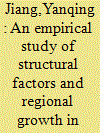

|
|
|
|
|
| Publication |
2010,
|
| Summary/Abstract |
Based on data of 31 Chinese provinces over the period 1980-2004, the study in this paper presents new evidence on the effects of structural shocks and structural transformation on growth and convergence among the Chinese regions. The division of overall regional growth in labour productivity into three components - growth due to structural shocks, growth due to structural transformation and a 'residual' indicating growth due to region-specific changes - provides us with a better framework than the traditional one-sector Solow growth model for attributing growth and convergence to various different sources. Among other findings, the study has shown that during 1990-1999, structural shocks worked to widen the gap between rich regions and poor regions in China, while structural transformation worked to narrow the gap.
|
|
|
|
|
|
|
|
|
|
|
|
|
|
|
|
| 2 |
ID:
099773
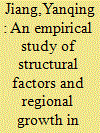

|
|
|
|
|
| Summary/Abstract |
Based on data of 31 Chinese provinces over the period 1980-2004, the study in this paper presents new evidence on the effects of structural shocks and structural transformation on growth and convergence among the Chinese regions. The division of overall regional growth in labour productivity into three components - growth due to structural shocks, growth due to structural transformation and a 'residual' indicating growth due to region-specific changes - provides us with a better framework than the traditional one-sector Solow growth model for attributing growth and convergence to various different sources. Among other findings, the study has shown that during 1990-1999, structural shocks worked to widen the gap between rich regions and poor regions in China, while structural transformation worked to narrow the gap.
|
|
|
|
|
|
|
|
|
|
|
|
|
|
|
|
| 3 |
ID:
147503


|
|
|
|
|
| Summary/Abstract |
China is switching from economic growth based on extremely rapid capital accumulation to economic growth based on structural reforms and accelerated total factor productivity growth. Meanwhile, China will also face a serious excess saving problem as capital accumulation slows and, hence, needs to reduce its private saving rate. Based on this analysis, we estimated the economic impact of China's growth slowdown and hypothetical economic transformation on Japan, the USA and Germany using the world input–output database. We compared the following three scenarios for China's final demand in 2020 and economic growth from 2015 to 2020: (i) an optimistic scenario (GDP growth rate = 6.2%, investment/GDP = 0.501); (ii) a slowdown scenario (GDP growth rate = 4%, investment/GDP = 0.501); and (iii) a structural reform scenario (GDP growth rate = 6.2%, investment/GDP = 0.3). Our analysis suggests that Japan and Germany would suffer more from structural reforms in China than from a slowdown in growth. Meanwhile, for the USA, the employment decline triggered by structural reforms would be much smaller than the employment decline caused by a slowdown in growth.
|
|
|
|
|
|
|
|
|
|
|
|
|
|
|
|
| 4 |
ID:
169748
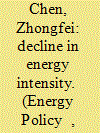

|
|
|
|
|
| Summary/Abstract |
Global energy intensity has decreased significantly during the past two decades. Against this background, this study aims to investigate a novel relationship between development of the financial system (financial development) and energy intensity and explore the underlying mechanisms influencing the relationship between these two indicators. Using long-term country-level data and a two-way fixed-effect model, this study reveals that financial development exerts a significant negative effect on energy intensity for non-OECD countries. However, financial development has a limited impact on energy reduction for OECD countries as a result of the mature financial systems of these developed economies. The estimated results are robust for various specifications. In addition, we reveal a U-shaped relationship between financial development and energy intensity in developing countries. Our results suggest that the influence of financial development on energy intensity reduction can be achieved through technological progress and innovation. Our findings suggest that stimulating financial development is an efficient way to reduce national energy intensity, and specific long-term policies must be established in order to balance the trade-off between financial development, economic growth, and energy intensity.
|
|
|
|
|
|
|
|
|
|
|
|
|
|
|
|
| 5 |
ID:
160001


|
|
|
|
|
| Summary/Abstract |
Allocative inefficiency in agriculture is an issue puzzling researchers and policy‐makers in China. Based on household data from the China Family Panel Studies of 2012, the present paper quantifies the potential distortions in China's agricultural production and examines their underlying determinants across regions. The results reveal that there are different levels of distortions across regions. The Middle region is facing the greatest distortion. Increases in machinery input, the proportion of non‐farm income and effective labor input will reduce distortions. Household saving, farmland rent and farmland size are significantly positively related to distortions. There is a complementary effect between labor and farmland in alleviating production inefficiency, but substitution effects exist between capital and farmland and also capital and labor. The increase in farmland size will aggravate the impact of capital on distortions. Given the constraint of super small‐scale farmland, facilitating land transfer is a necessary precondition for improving allocative efficiency.
|
|
|
|
|
|
|
|
|
|
|
|
|
|
|
|
| 6 |
ID:
112721


|
|
|
|
|
| Publication |
2012.
|
| Summary/Abstract |
In view of the importance of intra-firm trade and export-platform FDI conducted by multinationals, we investigate how domestic firms and foreign affiliates exhibited differential impacts of export entry and exit on productivity changes. Using a comprehensive dataset from China's manufacturing industries, we employ the Olley-Pakes method to estimate firm-level TFP and the matching techniques to isolate the impacts of export participation on firm productivity. Robust evidence is obtained that domestic firms displayed significant productivity gains (losses) upon export entry (exit), whereas foreign affiliates showed no evident TFP changes. Moreover, the productivity gains for domestic export starters were more pronounced in high- and medium-technology industries than in low-technology ones. We explain our findings from the perspective of the technology gap theory after considering processing trade and the fragmentation of production stages in the era of globalization.
|
|
|
|
|
|
|
|
|
|
|
|
|
|
|
|
| 7 |
ID:
150430


|
|
|
|
|
| Summary/Abstract |
Does a trade-off exist between energy efficiency and economic growth? This question underlies some of the tensions between economic and environmental policies, especially in developing countries that often need to expand their industrial base to grow. This paper contributes to the debate by analyzing the relationship between energy efficiency and economic performance at the micro- (total factor productivity) and macro-level (countries' economic growth). It uses data on a large sample of manufacturing firms across 29 developing countries to find that lower levels of energy intensity are associated with higher total factor productivity for the majority of these countries. The results are robust to a variety of checks. Suggestive cross-country evidence points towards the same relation measured at the macro-level as well.
|
|
|
|
|
|
|
|
|
|
|
|
|
|
|
|
| 8 |
ID:
113012


|
|
|
|
|
| Publication |
2012.
|
| Summary/Abstract |
Does foreign direct investment (FDI) into developing countries affect the growth of local firms in host countries? Using a dataset of 38 sectors in China's electrical and electronics industry, in this paper, we analyze whether FDI has a positive effect on local firms, with technology spillovers, added value and increasing total factor productivity, or a negative, market stealing, effect. Estimating the relationship between growth of local firms and investment of foreign firms, our results show that FDI is likely to have a negative impact on the growth of local firms in sectors with large disparities in technology and less experience in business. Therefore, local firms lacking in technology need to find markets with no competition from foreign firms or determine strategies to compensate technology disparities.
|
|
|
|
|
|
|
|
|
|
|
|
|
|
|
|
| 9 |
ID:
105278
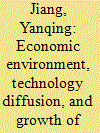

|
|
|
|
|
| Publication |
2011.
|
| Summary/Abstract |
This paper examines the effects of the regional economic environment and technology diffusion on China's regional total factor productivity (TFP) growth. We build a model of TFP growth in which Chinese regions achieve growth in TFP by making use of technology spillovers from the world technology frontier. We hypothesize that given the world frontier level of TFP, China's regional TFP growth is positively related to regional openness and negatively related to the current level of regional TFP. Empirical analysis in this paper of 29 province-level regions in China strongly supports our hypothesis. By using a nonlinear least squares regression method, we show that regional openness has a significantly positive effect on regional TFP growth. As a by-product, we also estimate a value of the output elasticity of capital that conforms to its traditionally accepted values. The findings of this paper lend strong support to the claim that the opening up process of China promotes the country's economic growth.
|
|
|
|
|
|
|
|
|
|
|
|
|
|
|
|
| 10 |
ID:
161486


|
|
|
|
|
| Summary/Abstract |
The objective of this study is to analyse the effect of debt on economic growth as well as the channels, that is, investment, total factor productivity (TFP), interest rate and saving channel through which debt affects economic growth in South Asian countries. The study uses growth model based on conditional convergence and augments to include debt. Panel data of four South Asian countries from 1990 to 2013 at annual frequency are utilized and fixed effect model is used for estimation. The results of the study showed that inverted U-shaped relationship exists between debt and economic growth in South Asian countries. However, the most important and significant channel through which debt affects economic growth is private and public investment as well as TFP. Reducing debt accumulation alone will not rectify the problem unless the supplementary macroeconomic policies are made sound; therefore, there is a dire need to improve macroeconomic policies, good governance and elimination of structural distortions.
|
|
|
|
|
|
|
|
|
|
|
|
|
|
|
|
| 11 |
ID:
151197


|
|
|
|
|
| Summary/Abstract |
Measurement of the productivity of firms is an important research issue in productivity literature. Over the years, various methods have been developed to measure firm productivity across the globe. But there is no unanimity on the use of methods, and research on the identification of factors which determine productivity has been neglected. In view of these gaps, this study aims to measure total factor productivity (TFP) and tries to identify firm-specific factors which determine productivity of Indian manufacturing companies. The study is based on data of 616 firms from 1998–99 to 2012–13. To measure TFP, the Levinsohn–Petrin (L-P) method has been employed, and the fully modified ordinary least squares (FMOLS) method has been used to identify factors that affect TFP. The results reveal that embodied and disembodied technology plays a crucial role in the determination of productivity overall in manufacturing and other sub-industries. Similarly, the size of firms and intensity of raw material imports are also important for the determination of productivity across the sub-industries.
|
|
|
|
|
|
|
|
|
|
|
|
|
|
|
|
| 12 |
ID:
140697


|
|
|
|
|
| Summary/Abstract |
examine the Koizumi Junichiro era in Japan to derive lessons for the current Abe Shinzo administration that vows to get Japan back on the path of sustainable growth. Standard growth theory identifies total factor productivity (TFP) as the key to sustainable growth. The existing empirical evidence clearly indicates that economic recovery during Koizumi's tenure was accompanied by robust growth of TFP. To account for this improvement in TFP performance, I focus on three developments during Koizumi's term: promotion of competition by introducing market discipline to various sectors of the economy, effectiveness of market entry and exit, and use of foreign competitive pressure to enhance domestic efficiency.
|
|
|
|
|
|
|
|
|
|
|
|
|
|
|
|
| 13 |
ID:
138899


|
|
|
|
|
| Summary/Abstract |
China has witnessed an unprecedented great leap forward in investment since the 2008 global financial crisis, and at the same time real GDP growth has undergone a significant slowdown. This paper examines China's growth slowdown since 2008 up to 2013 using a growth accounting model in a systematic way. It is found that China's growth slowdown since 2008 almost completely comes from a sharp slowdown in total factor productivity growth. During this period, the positive effect on growth from expanding investment has been completely offset by the negative effect of the slowdown in total factor productivity growth. Currently, China's economy has slid into the Solow downward path. Under these circumstances, a soft landing is completely infeasible. Unless the Chinese Government implements substantial rebalancing and comprehensive and in-depth market-oriented reform, accompanied by large-scale de-investment (decreasing in the ratio of investment in GDP) and massive employment adjustment, China will be unable to avoid the Solow downward path, and a hard landing in investment will be inevitable in the near future.
|
|
|
|
|
|
|
|
|
|
|
|
|
|
|
|
| 14 |
ID:
121193


|
|
|
|
|
| Publication |
2013.
|
| Summary/Abstract |
Empirical studies on total factor productivity growth (TFPG) in developing countries highlight trade openness, research and development and market structure as being the most important determinants of TFPG. The role of institutions remains overlooked in the literature on the determinants of TFPG. In this article, we look into the role of institutional quality as captured by effective state-business relationships (SBRs) in influencing TFPG, using Indian manufacturing as a case study. By SBRs we mean a set of highly institutionalized, responsive and public interactions between the state and the business sector. To compute TFPG, we use firm level data for both the formal and informal manufacturing sectors. We correct for the simultaneity bias associated with the production function approach for TFPG estimation by employing a method developed by Levinsohn and Petrin. We propose measures of effective SBRs for 15 Indian states over the period 1994-2005, and then use them in TFPG equations to estimate the effect of SBR on TFPG. The results indicate that SBR has positively affected the TFPG of Indian industry. The effect, however, is primarily for the formal sector.
|
|
|
|
|
|
|
|
|
|
|
|
|
|
|
|
| 15 |
ID:
161890


|
|
|
|
|
| Summary/Abstract |
Intangible capital is treated as an important determinant of economic growth in the age of knowledge economy. It has however attracted less attention in China largely due to measurement impediment. This study aims to measure intangible investment and examine its contribution to regional economic growth in China. The results show that both the coastal and interior regions in China enjoyed high growth in intangible investment during 2003–2014, especially after the year 2008. Moreover, it is found that regional disparity in intangible capital is widening and that this trend is mainly driven by the enlarging gap in investment in computer software and architecture designs. In addition, it is observed that economic competency capital is neglected in both regions, implying generally poor enterprise management in China. When intangible capital is considered, growth accounting exercises show higher labor productivity growth together with a larger effect of capital deepening in both regions. Coastal regions tend to benefit more from intangible capital due to the advancement of computerization. If the contribution of computer software in the interior region was as large as that in the coast region, labor productivity growth of the interior would be 0.5 percentage points higher than its current level. Finally, the estimates of the contribution of total factor productivity to economic growth would be biased if intangible capital is not considered.
|
|
|
|
|
|
|
|
|
|
|
|
|
|
|
|
| 16 |
ID:
121742
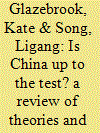

|
|
|
|
|
| Publication |
2013.
|
| Summary/Abstract |
This paper reviews the key theories relating to the role of education in economic development and social change and how education, as a critical component of total factor productivity, contributes to sustained economic growth. It examines how China's education policy reflects the country's unique dual economy. Focusing on the post-reform period, the paper contends that while progress has been made, there are risks to China's future growth prospects from failing to reap the benefits of sound education policy. It argues that if the Chinese education system is to continue to be a driver of rather than a drain on economic growth, and if China is to successfully manage its transition towards more inclusive, sustainable and equitable growth, reforms will be needed to improve the quality of education at all levels and to create an environment in which China's extensive human capital is duly recognized and respected. Crucially, the education system should be transformed to ensure it promotes a comprehensive range of human capabilities, including those that go beyond the part humans play in augmenting production possibilities.
|
|
|
|
|
|
|
|
|
|
|
|
|
|
|
|
| 17 |
ID:
111483


|
|
|
|
|
| Publication |
2012.
|
| Summary/Abstract |
Through review of relevant studies and analysis, this article indicates that the "middle-income trap" is in line with the framework of the mainstream economic growth theories, and, therefore, it is a useful concept through which we can analyze economic growth phenomena in specific economic growth phases. The empirical experiences of many countries also indicate that at specific middle-income stages, economies with high rates of growth tend to encounter economic slowdown or even stagnation. The article shows that China is facing the challenge of determining how to move smoothly beyond the middle-income stage of economic development, while taking into account the shifting population structure, changing resource endowment and growth patterns. The article, drawing on international experiences, puts forward several policy suggestions relating to improvement in total factor productivity, expansion of human capital accumulation and deepening of system and government function reforms.
|
|
|
|
|
|
|
|
|
|
|
|
|
|
|
|
| 18 |
ID:
111146


|
|
|
| 19 |
ID:
119155


|
|
|
|
|
| Publication |
2013.
|
| Summary/Abstract |
As a result of the shrinking working age population (aged 15 to 59 years), all factors that have driven China's rapid economic growth over the past 30 years tend to diminish from 2010. The present paper estimates the average annual growth rate of potential output to be 7.2 percent over the 12th Five-year Plan period and 6.1 percent over the 13th Five-year Plan period. Future sustainable growth requires furthering economic reform in related areas to enhance potential growth. This paper simulates two scenarios in which both an increase in labor force participation and improvement in total factor productivity can significantly enhance the potential GDP growth rate. Relevant policy implications are discussed.
|
|
|
|
|
|
|
|
|
|
|
|
|
|
|
|
| 20 |
ID:
137598


|
|
|
|
|
| Summary/Abstract |
After more than three decades of rapid growth, China's economy is going through an important turning point, where structural imbalances in both supply and demand sides must be addressed for a more moderate and sustainable growth path. By focusing on the structural changes to its ownership, a central element in China's economic transformation under market reform, the present paper highlights the importance of private entrepreneurship in deepening market reform and, thereby, in driving economic growth in a more efficient and sustainable way. Based on a perspective of resource allocation and a conceptual framework of entrepreneurship, the paper elaborates on the evolution of the private sector and its performance in the context of ownership reform, making comparisons with the performance of the state sector. The analysis suggests that there is further room for more productive use of economic resources, especially capital, land and natural resources, by increasing the participation of private entrepreneurs in industries with high entry barriers in favor of state-owned enterprises. Moreover, more competitive and equal access to productive resources through reform is needed to promote more productive entrepreneurship and to reduce rent-seeking activities.
|
|
|
|
|
|
|
|
|
|
|
|
|
|
|
|
|
|
|
|
|